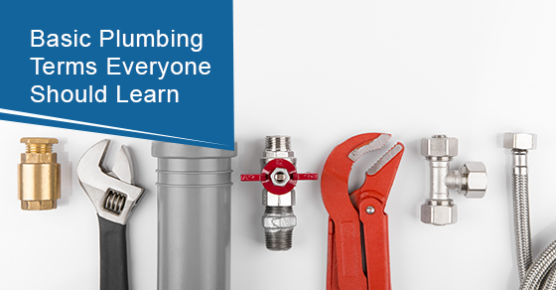


Plumbing systems are complex. There are a lot of parts doing many different things. While it’s unrealistic to learn the name of every plumbing component in your home and what it does, familiarizing yourself with a few basic terms is hugely beneficial.
For one, this helps you understand what your plumber is saying after they diagnose whatever plumbing problem you’re experiencing. Second, it helps you describe the plumbing problem to your plumber prior to inspection.
In the article, we’ll discuss some fundamental plumbing terms that everyone should understand.
This is one term that you definitely should know. The shut-off valve stops the flow of water in the pipe during failures or repairs. They are found next to toilets and sinks. If you need to stop the flow of water, then turn the shut-off valve clockwise.
Grey water drains from the sink, bathtub, shower, dishwasher, and washing machine. It typically contains contaminants from soap, grease, and other impurities.
You can’t drink it. However, eco-friendly homeowners sometimes use it to water their flower gardens or lawn.
Black water, on the other hand, comes from toilets. It can contain dangerous pathogens and always flows into the sewer or septic system.
Do you have a clogged drain? A blow bag (also known as a plumbing bladder) may be able to help. To use it, attach this heavy-duty rubber bag to the garden hose. Push the bag into the clogged drain as far as it will go.
Turn on the water, which inflates the bag and forces it into the clog. This is usually enough to send the clog down the drain.
Note, though, that blow bags are not recommended for toilet clogs! The reason is that the toilet pipes are too wide.
Plumbing snakes, also known as augers, are fantastic for clearing clogged pipes. They are long, flexible metal rods with sharp ends. You can find them in various sizes for the different pipes in your home.
Professional plumbing augers are longer and sturdier than the ones sold at home improvement stores.
This one is fairly self-explanatory. The main is the primary channel of the drain and water supply system. Every pipe in your home is connected to the main.
A sanitary tee is used only in waste lines where sanitation is critical. As the name suggests, this plumbing fitting is shaped like the letter “T.” It connects a new pipe to the middle of an existing one.
Every drain has a plumbing trap. Pipes with an inverted “P” or “S” shape allow a pool of water to collect below the drain, thus sealing the drain.
It catches solid objects that could clog the drain line, preventing sewer gases and other unpleasant realities of sewage from crawling back into your home.
A flapper valve fits over the opening at the bottom of a toilet’s tank. This rubber plug seals shut after you flush, allowing the toilet bowl to fill with water.
Alternatively, when you press the toilet handle to flush, the flapper raises.
Cheater valves are used whenever it’s difficult to vent a fixture drain. This often happens when installing island sinks or bathroom sinks far from the main vent stack.
The proper name for a cheater valve is an “air admittance valve” (AAV) or Studor valve. Installing this device on a P-trap allows air into the pipe to keep the water flowing.
There’s a float valve in your toilet. It automatically shuts the water off at a certain level, which you can set.
Temperature and pressure relief valves, or T&P valves, are safety devices commonly found on the top of water heater tanks.
When the water in the tank gets too hot, the pressure builds up within the tank. T&P valves release this pressure to prevent the hot water tank from exploding.
O-Rings play a key role in preventing leaks and costly water leakage. They are round, rubber washers used to create watertight seals on valves.
Copper pipes and fittings are joined through a process called “sweating.” First, a soapy substance called flux is applied to the joint. This removes any oxidation on the copper and allows for a clean connection.
Solder (a soft metal alloy) is then melted with a torch to join the pipe and fitting. This creates a watertight connection.
PEX water pipes are made from cross-linked polyethylene, which is bendable, easy to assemble, and comes in two helpful colours: red for hot, and blue for cold. It’s considerably cheaper than copper.
However, if your home already has copper pipes, then PEX tubing can be integrated into your existing copper system.
This is the main vent pipe connecting the sewer to the roof. It looks like a miniature smokestack sticking out of the roof of every house. A vent stack’s role is to dissipate harmful gases from the sewer into the atmosphere and allow air into the pipes.
The influx of air equalizes the pressure within the pipes, thus ensuring that the flow of liquids continues at the proper pace.
A water hammer is not a tool, but a word used to describe a specific condition. If you have ever heard loud banging sounds coming from your pipes, that’s a water hammer.
It occurs when there is too much pressure in your pipes or pipe configuration. This problem can be solved with a water hammer arrestor (or by reducing the water pressure in the pipes).
Overflow drains prevent water from flowing over sinks and tubs. They reroute excess water into the drain pipe once it reaches a certain level.
Is there a problem with your plumbing? If so, then Advanced Plumbing can help. We offer a wide range of plumbing repair, renovation, and maintenance services.
If you need a plumber in Toronto, contact Advanced Plumbing. To book an appointment, call us today at 866-863-9539 or contact us here.